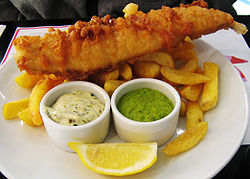 | |
| Place of origin | United Kingdom |
|---|---|
| Region or state | England |
Mushy peas are dried marrowfat peas which are first soaked overnight in water with baking soda, and then rinsed in fresh water, after which the peas are gathered in a saucepan, covered with water, and brought to a boil, and then simmered until the peas are softened. The mush is seasoned with salt and pepper. [1]
Contents
Throughout England and Scotland they are a traditional accompaniment to fish and chips. In Northern England they are also commonly served as part of a popular snack called pie and peas (akin to the South Australian pie floater; but instead of the thick pea soup of the floater, in pie and peas it is mushy peas which accompany the meat pie) and are considered to be a part of traditional British cuisine. They are sometimes also packed into a ball, dipped in batter, deep-fried, and served as a pea fritter. [2] Mushy peas can also be bought ready-prepared in tin cans.
